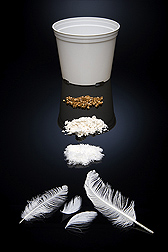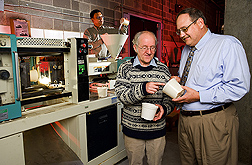Feathers Can Be for More Than Pillow Stuffin’
If at first you don’t succeed, try, try again. For some, that is just an old saying; to others, it is a mantra. ARS chemist Walter Schmidt has lived it for years.
Schmidt, in the Environmental Management and Byproduct Utilization Laboratory in Beltsville, Maryland, develops practical uses for discarded chicken feathers. About 4 billion pounds of feathers are generated each year during the poultry production process.
In 1998, ARS published its first story about Schmidt’s research—using chicken feather fiber in the formation of plastics. Schmidt’s persistence has paid off. In collaboration with the Horticultural Research Institute (HRI)—the research and development endowment of the American Nursery and Landscape Association, based in Washington, D.C.—Schmidt and HRI research associate Masud Huda have formulated planting pots that can degrade over variable periods of time—from 1 to 5 years.
The pots look and feel like any other plastic planters encountered at your local nursery, but they are made to disintegrate naturally, without harm to the environment. In fact, the pots—manufactured without any petroleum components—would slowly release beneficial nitrogen into the soil.
While feathers are routinely processed into feather meal—a livestock feed ingredient—there are a lot more chicken feathers available. Why can’t they just be used to stuff pillows?
Chicken Processing Industry
Chicken processors are very efficient businesses, finding ways to automate most of the procedures for getting chickens from farm to market. They have also reduced the amount of water used during processing. But when all is said and done, they are still left with a lot of feathers.
Goose down is used to stuff very comfortable and expensive pillows. Though chicken feathers are used in some inexpensive pillows, they don’t offer quite the same qualities. Chicken feathers are shorter, with more prickly quills, and are not as fluffy as goose down feathers. While these attributes limit their market value in making pillows, chicken feathers remain very appropriate for other commercial applications.
From Plastics to Paper to Flowerpots
In 1993, Schmidt found that feather fiber—alone or in combination with wood pulp—can be made into paper. That discovery led to decorative paper, filter paper, filters, and absorbents. Schmidt and his colleagues developed the technology to clean the feathers, separate them into fiber and quill fractions, and convert each fraction into fiber and fiber products at laboratory scale.
The fibers’ super-fine size and uniform shape make them excellent for use in air and water filtration. Most filters are made from wood pulp, but feather fiber has the advantage of being finer than wood pulp. “Wood pulp filters have a width of 10-20 microns, compared to 5 microns for filters made from feather fiber,” Schmidt notes. “Feather fiber filters have a finer mesh, resulting in smaller pores for trapping more minute particulates.”
Air filters made with feather fiber will have smaller holes, which would result in more spores, dust, dander, and other allergens being removed from the air and trapped in the filter. Another possible use for the filters would be in vacuum cleaners.
The process of converting feathers into fibers and fiber products was patented in 1998, and in 1999 the first pilot plant to convert feathers into fiber was in place.
In 2000, Schmidt and his colleague demonstrated that feathers and quill fibers can be added to plastic used in car parts, such as dashboards, to strengthen them and absorb noise while also reducing the weight of the parts.
Justin Barone, a research associate working with Schmidt, in 2002 found feather-derived plastic can be molded just like any other plastic and has properties very similar to commodity plastics such as polyethylene and polypropylene. “This makes the feather-derived plastic a unique material for packaging or any other application where high strength and biodegradability are desired,” Schmidt notes. In 2006, the process of making composites and films from feather keratin was patented by ARS.
Schmidt and Huda are now working to develop fully biodegradable flowerpots. HRI director of research Marc Teffeau says that several commercial pot manufacturers are involved in this phase to determine optimum molding specifications for the containers.
“Our goal is to develop biodegradable keratin-based resins that can be used by container manufacturers to provide environmentally sustainable alternatives to petroleum-based plastic pots, among other products,” says Teffeau. “In addition, we are working on biodegradability and composting trials of the materials to provide data to meet the ASTM-6400 standard for bioplastics.”
“The end products will not only help solve the environmental problem of creating biodegradable plastics, but they will also provide a cost-effective commercial use for feathers,” says Schmidt.—By Sharon Durham, Agricultural Research Service Information Staff.
This research is part of Manure and Byproduct Utilization, an ARS national program (#206) described on the World Wide Web at www.nps.ars.usda.gov.
Walter F. Schmidt is in the USDA-ARS Environmental Management and Byproduct Utilization Laboratory, Henry A. Wallace Beltsville Agricultural Research Center, Bldg. 007, Room 224, 10300 Baltimore Ave., Beltsville, MD 20705; phone (301) 504-6765, fax (301) 504-5992.
"Feathers Can Be for More Than Pillow Stuffin’" was published in the September 2009 issue of Agricultural Research magazine.








